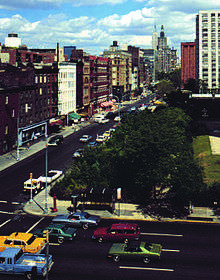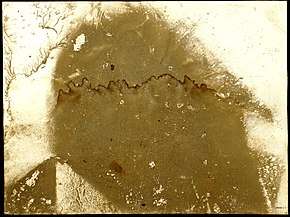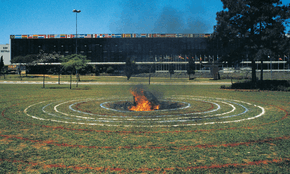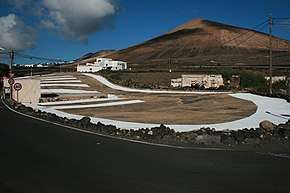Land art
Land art, variously known as Earth art, environmental art, and Earthworks, is an art movement that emerged in the 1960s and 1970s,[1] largely associated with Great Britain and the United States,[2][3][4] but which included examples from many countries. As a trend "Land art" expanded boundaries of art by the materials used and the siting of the works. The materials used were often the materials of the Earth including for instance the soil and rocks and vegetation and water found on-site, and the siting of the works were often distant from population centers. Though sometimes fairly inaccessible, photo documentation was commonly brought back to the urban art gallery.[3][5][6]


Concerns of the art movement centered around rejection of the commercialization of art-making and enthusiasm with an emergent ecological movement. The art movement coincided with the popularity of the rejection of urban living and its counterpart, an enthusiasm for that which is rural. Included in these inclinations were spiritual yearnings concerning the planet Earth as home to mankind.[7][8]
Form




In the 1960s and 1970s land art protested "ruthless commercialization" of art in America. During this period, exponents of land art rejected the museum or gallery as the setting of artistic activity and developed monumental landscape projects which were beyond the reach of traditional transportable sculpture and the commercial art market, although photographic documentation was often presented in normal gallery spaces. Land art was inspired by minimal art and conceptual art but also by modern movements such as De Stijl, Cubism, minimalism and the work of Constantin Brâncuși and Joseph Beuys. Many of the artists associated with land art had been involved with minimal art and conceptual art. Isamu Noguchi's 1941 design for Contoured Playground in New York is sometimes interpreted as an important early piece of land art even though the artist himself never called his work "land art" but simply "sculpture". His influence on contemporary land art, landscape architecture and environmental sculpture is evident in many works today.[9]
Alan Sonfist used an alternative approach to working with nature and culture by bringing historical nature and sustainable art back into New York City. His most inspirational work is Time Landscape, an indigenous forest he planted in New York City.[9] He also created several other Time Landscapes around the world such as Circles of Time in Florence Italy documenting the historical usage of the land, and recently at the deCordova Sculpture Park and Museum outside Boston. According to critic Barbara Rose, writing in Artforum in 1969, he had become disillusioned with the commodification and insularity of gallery bound art. In 1967, the art critic Grace Glueck writing in the New York Times declared the first earthwork was done by Douglas Leichter and Richard Saba at the Skowhegan School of Painting and Sculpture. The sudden appearance of land art in 1968 can be located as a response by a generation of artists mostly in their late twenties to the heightened political activism of the year and the emerging environmental and women's liberation movements.
One example of land art in the 20th century was a group exhibition created in 1968 at the Dwan Gallery in New York.[10] In February 1969, Willoughby Sharp curated the "Earth Art" exhibition at the Andrew Dickson White Museum of Art at Cornell University, Ithaca, New York. The artists included were Walter De Maria, Jan Dibbets, Hans Haacke, Michael Heizer, Neil Jenney, Richard Long, David Medalla, Robert Morris, Dennis Oppenheim, Robert Smithson, and Gunther Uecker. The exhibition was directed by Thomas W. Leavitt. Gordon Matta-Clark, who lived in Ithaca at the time, was invited by Sharp to help the artists in "Earth Art" with the on-site execution of their works for the exhibition.
Perhaps the best known artist who worked in this genre was the American Robert Smithson whose 1968 essay "The Sedimentation of the Mind: Earth Projects" provided a critical framework for the movement as a reaction to the disengagement of Modernism from social issues as represented by the critic Clement Greenberg.[11] His best known piece, and probably the most famous piece of all land art, is the Spiral Jetty (1970), for which Smithson arranged rock, earth and algae so as to form a long (1500 ft) spiral-shape jetty protruding into Great Salt Lake in northern Utah, U.S.. How much of the work, if any, is visible is dependent on the fluctuating water levels. Since its creation, the work has been completely covered, and then uncovered again, by water. A steward of the artwork in conjunction with the Dia Foundation,[12] the Utah Museum of Fine Arts regularly curates programming around the Spiral Jetty, including a "Family Backpacks" program.[13] Smithson's Gravel Mirror with Cracks and Dust (1968) is an example of land art existing in a gallery space rather than in the natural environment. It consists of a pile of gravel by the side of a partially mirrored gallery wall. In its simplicity of form and concentration on the materials themselves, this and other pieces of land art have an affinity with minimalism. There is also a relationship to Arte Povera in the use of materials traditionally considered "unartistic" or "worthless". The Italian Germano Celant, founder of Arte Povera, was one of the first curator to promote Land Art.[14]
'Land Artists' have tended to be American,[2] with other prominent artists in this field including, Carl Andre, Alice Aycock, Walter De Maria, Hans Haacke, Michael Heizer, Nancy Holt, Ana Mendieta, Dennis Oppenheim, Andrew Rogers, Charles Ross, Alan Sonfist, and James Turrell. Turrell began work in 1972 on possibly the largest piece of land art thus far, reshaping the earth surrounding the extinct Roden Crater volcano in Arizona. Perhaps the most prominent non-American land artists are the British Chris Drury, Andy Goldsworthy, Richard Long and the Australian Andrew Rogers.[15] In 1973 Jacek Tylicki begins to lay out blank canvases or paper sheets in the natural environment for the nature to create art.
Some projects by the artists Christo and Jeanne-Claude (who are famous for wrapping monuments, buildings and landscapes in fabric) have also been considered land art by some, though the artists themselves consider this incorrect.[16] Joseph Beuys' concept of 'social sculpture' influenced 'Land art' and his '7000 Eichen' project of 1982 to plant 7000 Oak trees has many similarities to 'Land art' processes. Rogers' “Rhythms of Life” project is the largest contemporary land-art undertaking in the world, forming a chain of stone sculptures, or geoglyphs, around the globe – 12 sites – in disparate exotic locations (from below sea level and up to altitudes of 4,300 m/14,107 ft). Up to three geoglyphs (ranging in size up to 40,000 sq m/430,560 sq ft) are located in each site.
Land artists in America relied mostly on wealthy patrons and private foundations to fund their often costly projects. With the sudden economic down turn of the mid-1970s funds from these sources largely stopped. With the death of Robert Smithson in a plane crash in 1973 the movement lost one of its most important figureheads and faded out. Charles Ross continues to work on the Star Axis project, which he began in 1971. Michael Heizer continues his work on City, and James Turrell continues to work on the Roden Crater project. In most respects, "land art" has become part of mainstream public art and in many cases the term "land art" is misused to label any kind of art in nature even though conceptually not related to the avant-garde works by the pioneers of land art.
The Earth art of the 1960s were sometimes reminiscent the much older land works, Stonehenge, the Pyramids, Native American mounds, the Nazca Lines in Peru, Carnac stones and Native American burial grounds, and often evoked the spirituality of such archeological sites.[8][3]
Contemporary land artists
- Vito Acconci
- Betty Beaumont
- Milton Becerra
- Marinus Boezem
- Chris Booth
- Eberhard Bosslet
- Alberto Burri
- Mel Chin
- Christo and Jeanne Claude
- Marlene Creates
- Walter De Maria
- Lucien den Arend
- Agnes Denes
- Jan Dibbets
- Harvey Fite
- Barry Flanagan
- Hamish Fulton
- Andy Goldsworthy
- Michael Heizer
- Nancy Holt
- Junichi Kakizaki
- Maya Lin
- Richard Long
- Robert Morris
- Vik Muniz
- David Nash
- Ugo Rondinone
- Dennis Oppenheim
- Georgia Papageorge
- Beverly Pepper
- Andrew Rogers
- Charles Ross
- Richard Shilling
- Nobuo Sekine
- Robert Smithson
- James Turrell
- Jacek Tylicki
- Nils Udo
- Bill Vazan
- Strijdom van der Merwe
- Seth Wulsin
- Olafur Eliasson
See also
References
Notes
- "Land art – Art Term". Tate.
- Kastner, Jeffrey (June 23, 2010). "Land and Environmental Art". Phaidon Press – via Google Books.
- Art in the modern era: A guide to styles, schools, & movements. Abrams, 2002. (U.S. edition of Styles, Schools and Movements, by Amy Dempsey) ISBN 978-0810941724
- "Earth Art Movement Overview". The Art Story.
- http://mymodernmet.com Unexpected Land Art Beautifully Formed in Nature.
- http://www.land-arts.com Land art.
- ArtSpeak, A Guide to Contemporary Ideas, Movements, and Buzzwords, 1945 to the Present, By Robert Atkins, Abbeville Press, 2013, ISBN 978-0-78921-150-7
- "Land Art: Earthworks that Defined Postwar American Art". Art & Antiques Magazine. April 4, 2012.
- Udo Weilacher, Between Landscape Architecture and Land Art. Birkhäuser, 1999, Basel Berlin Boston 1999 ISBN 3-7643-6119-0
- "Leftmatrix". leftmatrix.com. Archived from the original on January 7, 2011. Retrieved February 8, 2011.
- Francis Frascina, Art, Politics and Dissent: Aspects of the Art Left in Sixties America, Manchester University Press, 1999, p. 142, ISBN 0719044693
- Arts, Utah Museum of Fine. "UMFA: Utah Museum of Fine Arts". Archived from the original on 2016-10-18. Retrieved 2016-09-15.
- "Family Backpacks Archived 2016-10-18 at the Wayback Machine". Utah Museum of Fine Arts. umfa.utah.org. July 30, 2017.
- "Observatoire du Land Art". obsart.blogspot.fr. Retrieved June 2, 2012.
- "Monumental Land Art of the United States". daringdesigns.com. Retrieved August 27, 2010.
- Christo and Jeanne-Claude. "Common Errors". Christojeanneclaude.net. Archived from the original on 2003-02-08. Retrieved 2008-11-07.CS1 maint: uses authors parameter (link)
Further reading
- Lawrence Alloway, Wolfgang Becker, Robert Rosenblum et al., Alan Sonfist, Nature: The End of Art, Gli Ori, Dist. Thames & Hudson Florence, Italy,2004 ISBN 0-615-12533-6
- Max Andrews (Ed.): Land, Art: A Cultural Ecology Handbook. London 2006 ISBN 978-0-901469-57-1
- John Beardsley: Earthworks and Beyond. Contemporary Art in the Landscape. New York 1998 ISBN 0-7892-0296-4
- Suzaan Boettger, Earthworks: Art and the Landscape of the Sixties. University of California Press 2002. ISBN 0-520-24116-9
- Amy Dempsey: Destination Art. Berkeley CA 2006 ISBN 9780520250253
- Michel Draguet, Nils-Udo, Bob Verschueren, Bruseels: Atelier 340, 1992
- Jack Flam (Ed.). Robert Smithson: The Collected Writings, Berkeley CA 1996 ISBN 0-520-20385-2
- John K. Grande: New York, London. Balance: Art and Nature, Black Rose Books, 1994, 2003 ISBN 1-55164-234-4
- Eleanor Heartney, Andrew Rogers Geoglyphs, Rhythms of Life, Edizioni Charta srl, Italy, 2009 ISBN 978-88-8158-712-4
- Robert Hobbs, Robert Smithson: A Retrospective View, Wilhelm Lehmbruck Museum, Duisburg / Herbert F. Johnson Museum of Art, Cornell University,
- Jeffrey Kastner, Brian Wallis: Land and Environmental Art. Boston 1998 ISBN 0-7148-4519-1
- Lucy R Lippard: Overlay: Contemporary Art and the Art of Prehistory. New York 1983 ISBN 978-0-394-51812-1
- Udo Weilacher: Between Landscape Architecture and Land Art. Basel Berlin Boston 1999 ISBN 3-7643-6119-0
- John K. Grande, Edward Lucie-Smith (Intro): Art Nature Dialogues: Interviews with Environmental Artists, New York 2004 ISBN 978-0-7914-6194-5
- John K. Grande, David Peat & Edward Lucie-Smith (Introduction & forward) Dialogues in Diversity, Italy: Pari Publishing, 2007, ISBN 978-88-901960-7-2
- Chris Taylor and Bill Gilbert. Land Arts of the American West. Austin: University of Texas Press; 2009. ISBN 978-0-292-71672-8
- Gilles A. Tiberghien: Land Art. Ed. Carré 1993/1995/2012
- Larisa Dryansky, ""Cartophotographies : de l'art conceptuel au Land Art"", Paris, éditions du Comité des travaux historiques et scientifiques-Institut national d'histoire de l'art, 2017.
External links
| Wikimedia Commons has media related to Land art. |
| Wikiquote has quotations related to: Land art |
- Alan Sonfist Official Website
- Artist in Nature International Network
- Denarend.com - About land art
- Land Arts of the American West
- Official UNM Land Arts of the American West Program Website
- Land & Environmental Artists & Art
- Roden Crater by James Turrell
- Jacek Tylicki Land & Environmental Art projects
- Land Art project in South Africa
- Broken Circle
- OBSART | Observatoire du Land Art
- (in German) Using Land art as a form of advertising
- Center for Land Use Interpretation entry for Land Art
- The Case for Land Art | The Art Assignment | PBS